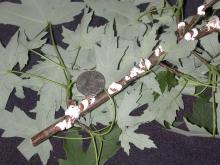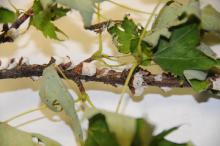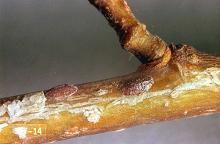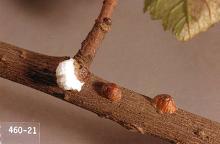Pulvinaria innumerabilis
See:
Pest description and crop damage Mature cottony maple scale are small, flat, oval, brown insects 0.25 to 0.375 inch in diameter. The "cotton" is really waxy threads, and the ovisac may contain over 1,500 eggs. The insects produce copious amounts of honeydew which can collect on foliage and branches and cause growth of sooty mold. Honeydew is also a nuisance when it falls on nearby cars and sidewalks, and it also attracts bees, wasps, and ants.
Occasionally, heavy outbreaks of this scale occur, usually on weakened or stressed trees. These outbreaks can cause the death of numerous small branches and occasionally the death of a tree.
Cottony maple scale reach epidemic numbers on silver maple, but noticeable populations can occur on red maple. It also is known to survive on other species of maple, honey and black locust, white ash, euonymus, oak, boxelder, dogwood, hackberry, sycamore, beech, elm, willow, basswood, and poplar.
Biology and life history Eggs hatch from mid-June to August and the crawlers emerge. The crawlers walk onto the leaves and tend to attach alongside the major leaf veins, usually on the underside. Here, the nymphs produce copious amounts of honeydew and grow by molting once. In September, the male scale emerge as tiny, winged, gnat-like insects that move around on the leaves in search of females. After mating, the males die and the females soon withdraw their mouthparts and crawl back onto small twigs and branches to overwinter.
Scouting and thresholds Inspect twigs during the dormant season for scale. Pay particular attention to weak plants. The crawlers are best observed during summer with a 10X magnifying glass.
Management-chemical control
See:
Chemical Control of Nursery Pests
Apply from June through summer.
For more information
Johnson, W.T. and H.H. Lyon (1991), Insects That Feed on Trees and Shrubs, 2nd ed., Cornell University Press (p. 342).





